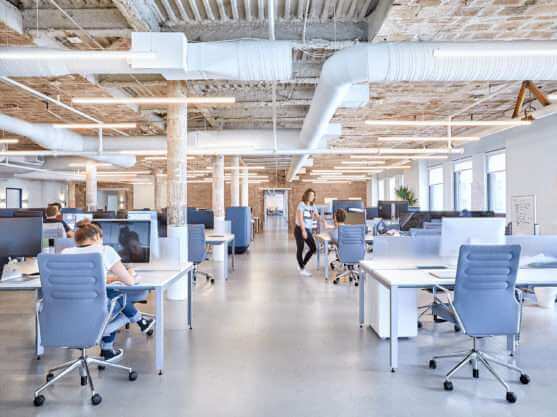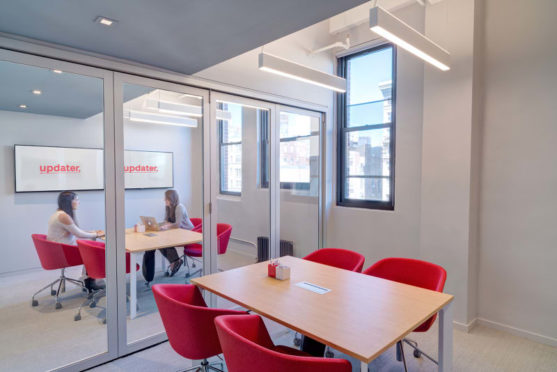You and your employees will spend at least 40 hours per week (and about 2,000 hours per year!) in the office. How you organize the space between those four walls can affect not just aesthetic appeal but also comfort and how much work gets done.
Reworking your office layout is about more than just utilizing the workplace efficiently. Studies show that office layout and other environmental factors affect employee well-being, financial success, and productivity. A poorly designed office can lead to “higher stress levels, emotional rifts between departments, corporate resentment, employee bickering, mental health issues, anxiety, and even physical problems such as backaches and reduced eye vision,” Jeff Pochepan writes for Inc.com. Properly utilizing office space, however, can foster collaboration, generate feelings of comfort and calm, provide employees with their own space, and promote productivity.
Planning the layout of your office space will require more than just rearranging some desks. Be prepared to select furniture, manipulate lighting, purposefully leave some floor space open, and purchase decor. Whether you’re moving into a brand new location, or your current space just needs a change, you’ve come to the right place to learn how to create an ideal environment for your business. Here’s what you need to know about optimizing your office layout before you make any purchases or hire professional design help.

1. Make a plan
Before you install a slide and buy everyone treadmill desks, you’ll want to sit down and make a budget to see what these changes and updates will cost. Next, you’ll want to determine who is going to make the decisions. If you have enough money, you might consider hiring an interior designer; arranging the space yourself will be less expensive but likely more time-consuming. Finally, be sure you consider the individual requirements of your employees and company. You may want to poll, share potential designs with, or at least talk to your direct reports to find out what kind of space they want to spend their time in.
2. Get rid of uncomfortable furniture
Before you arrange the furniture, consider whether or not it’s even a good idea to keep it. Old or poorly made furniture can cause employee health problems such as back pain, carpal tunnel syndrome, migraines, and eye strain. Finding ergonomic desk chairs is a great place to start. Look for chairs that feature armrest variations; swivel mechanisms; height, width, and depth adjustments; lumbar support; and padded material. While updating furniture or opting for something more expensive might hurt your wallet on the outset, it will save your employees pain and healthcare costs down the road.
3. Prioritize variety
No one-size-fits-all solution exists, so you’ll have to factor in the features of the space, the needs of your employees, and specifics about your company. However, every office setup should prioritize variety. “Creating different workspace environments within one office adds great flexibility,” said Warren Bricknell, managing director at Dale Office Interiors and co-owner of Scaletronic. “Having quiet areas, collaboration areas, and sometimes even game areas can really help employees to perform at their best. It’s about having the choice to work in a way that best suits the task at hand.”
4. Take note of technological requirements.
Before you start unwittingly moving desks away from phone jacks employees need to access, set up a time to speak with your IT department or head of engineering about how best to arrange the space so everyone can get to the technology they need. Consider factors such as the location of printers, storage for technology, proximity to outlets, wifi routers, and space for projectors and screens.
5. Include your employees in the process.
Research indicates that employees experience higher job satisfaction when managers allow them to control the setup of their own workspaces or choose where they want to work. This can mean letting your staff arrange the furniture how they want in their offices or order the type of furniture they want; or, it can mean giving them several options for workspaces throughout the office building. For example, one employee might like to answer emails in a private phone booth in the morning but venture into a shared space to collaborate with coworkers in the afternoon.

- Source: Harvard Business Review
6. Create spaces designed for collaboration
Encourage your employees to walk to different parts of the office and enjoy space dedicated to collaboration. Collaborative spaces can be as simple as computers set up on tables where multiple people can gather, or as comfortable as a few plush chairs in a semi-circle around a fireplace, indoor fountain, or art display. These spaces make great, modern alternatives to just meeting in someone’s office.
7. Pay attention to lighting
Lighting can impact productivity, health, mood, well-being, and depression. In fact, an American Society of Interior Design study indicated that 68% of employees are unhappy about the lighting situation in their offices. Take a stroll around your office and take note of spaces that are not getting enough light. Natural light is ideal, but this isn’t possible for all spaces, especially interior offices and cubicles. For these spaces, consider obtaining ceiling lights that imitate natural light or sunlight desk lamps.
8. Create a Space Just for Relaxing.
Taking breaks is important, and office space can help encourage employees to get away for a few minutes when they need to. Try designating work-free space in the office that doesn’t feature computers or work-related paraphernalia. “Today, people really want space to relax at work,” said Bricknell. “These spaces can come in all shapes and sizes but allow employees to feel more comfortable, express themselves, and collaborate better with their peers at work.”

9. Consider Office Temperature
While office temperature might seem like a separate issue from office layout, it’s not. For example, the sun’s shining through a window might make one area too warm, while an air conditioning vent located directly over an interior cubicle might make that space too cold. You won’t be able to account for every one of these issues, but some awareness of temperature variation throughout the office may help you make smart layout choices.
10. Leave Some Spaces Open
It might be tempting to jam as much furniture as you can into the office, but that can be visually overwhelming and make the office difficult to navigate. Think of your open space like white space on a resume. “Moderate levels of visual complexity are great: they give your mind something to do without being too busy or time-consuming,” says design psychologist Sally Augustin. Don’t be afraid to leave some spaces open and allow plenty of space for walking or gathering in a standing position.
11. Don’t Overdo the Decor
There’s nothing worse than a dark, bland office with good organization but no character or decorations. While it may be tempting to choose function over form when it comes to office design, a little creativity goes a long way. Try including some office plants, artwork, inspirational quotes, and company branding. However, be careful not to overdo it. Office decor should make the space look more aesthetically pleasing, not overwhelm employees and visitors.
12. Plan for Growth
A critical consideration while making plans for your office layout is growth. How many employees do you plan on adding in the next 6-12 months, and where will you fit their desks? How will this additional foot traffic affect common spaces and facilities? Will meeting rooms be constantly booked? Organize your space with the future in mind so you don’t have to reorganize and redecorate out of necessity. While the occasional office reorganization is healthy and ideal, but doing it too often will get pricey and time-consuming.




